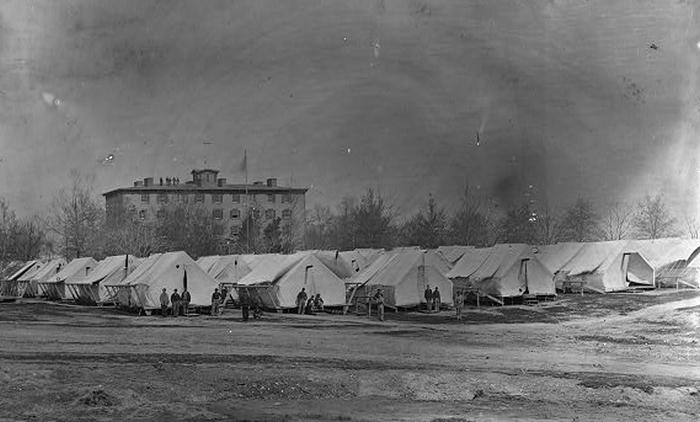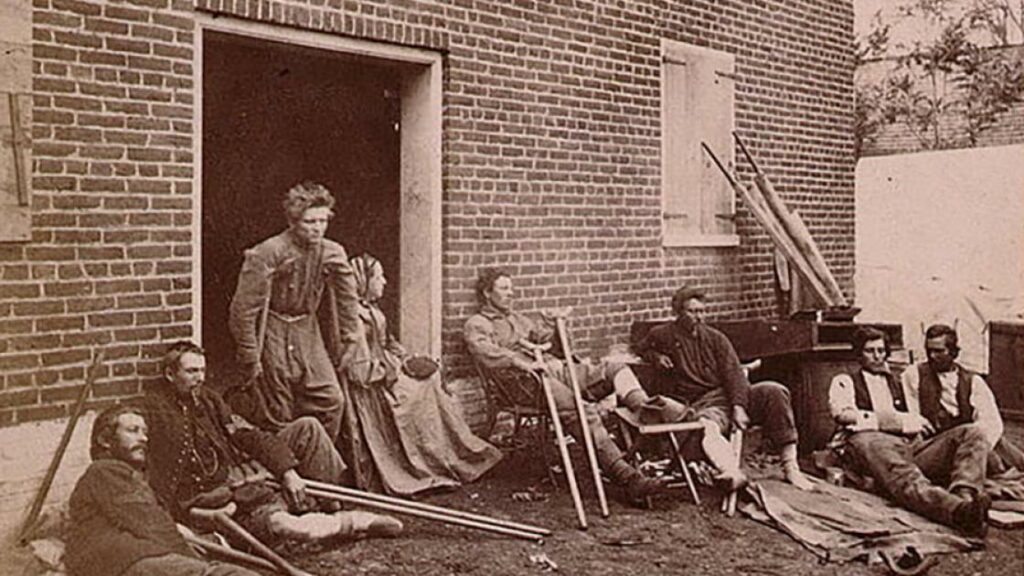Often when we think of the American Civil War, images of enormous battlefields and waves of soldiers immediately come to mind. However, there’s another, more gruesome side to the war that tends to go overlooked.
Casualties and deaths were many, but of course, not all took place on the battlefield. Wounded soldiers who survived the chaos of the battlefield found themselves behind the front lines in military and field hospitals, where even more danger awaited.
Medical knowledge was still minimal during the Civil War – far from where it is today, and doctors struggled to keep up with the carnage.
In a time before antiseptics and sterilization, amputations and surgeries were often done without proper sanitation. Disease ran rampant.
With soldiers and medical professionals alike forced to endure countless medical horrors, the reality of Civil War medicine is far more gruesome and horrific than expected.

Lack of Knowledge and Resources
Civil War medicine was conducted when medical knowledge was primitive, and doctors did not understand the causes of diseases.
Surgeons typically underwent only two years of medical school, with many admitted with little to no qualifications. Moreover, most had never treated a gunshot wound or performed surgery, leaving them woefully unprepared for the unprecedented scale of treatment they would be faced with during the war.
Although some 10,000 surgeons served in the Union army and about 4,000 in the Confederate army, they were often understaffed, underqualified, and undersupplied, working in what is described by some as the “medical middle ages.”
Despite this, they did their best, but the lack of knowledge about the use of sterile dressings, antiseptic surgery, and proper sanitation was a tragedy of the era.
This lack of understanding meant that medical officers did little to prevent infections, there were no antibiotics, and minor wounds easily became fatal.
At the same time, in Europe, the research of biologists Robert Koch and Louis Pasteur – known for their work on germ theory – was beginning to revolutionize medicine. Still, American physicians had yet to benefit from these advances.
All in all, the doctors and nurses of the Civil War were significantly unprepared for the scale and diversity of medical and logistical problems it faced throughout the war.
Inadequate Sanitation and Overcrowded Facilities
The Civil War camp and field hospital was far from the spotless facilities we’re used to today. Soldiers were exposed to disease and infection at just about every turn, and the complete picture is sickening.
Malaria was a particular risk in damp areas full of mosquitos, while ‘camp itch’ was caused by insects or skin diseases. The presence of insects and vermin, lack of clothing and shoes, poor food and water quality, and just general neglect of camp hygiene were all unnervingly common.
Many unqualified recruits were also allowed into the army, and diseases cruelly weeded out those who should have been excluded. Troops from rural areas were particularly vulnerable to exposure to diseases to which they had no immunity in the densely packed camps.

Neglect of camp hygiene was a universal problem. Both Union and Confederate armies dealt with mosquitoes and lice, and exposure turned many a cold into a case of pneumonia – the third leading cause of death during the war after typhoid and dysentery.
Additionally, it’s estimated that 995 out of 1000 Union troops eventually contracted chronic diarrhea or dysentery; their Confederate counterparts suffered similarly.
Clearly, the conditions in Civil War camps and field hospitals were far from ideal. Disease and infection ran rampant, affecting soldiers on both sides of the conflict. But the horrors didn’t stop there.
Civil War Surgery – Primitive and Terrifying
The severity of wounds from the ammunition used during the war was truly horrific. While many soldiers would survive being struck by rifle fire or artillery on the battlefield, back behind the lines, their situation turned much grimmer.
Amputations were the most common surgical procedures performed throughout the war, accounting for three of every four surgeries. The mortality rate for amputations was 26.3%, with about 30,000 out of 175,000 extremity wounds to Union soldiers resulting in amputation.
Only the most experienced and senior Civil War surgeons were allowed to perform amputations, as the public perception was that too many were being carried out. Still, the procedures were arguably archaic, and the details are hard to swallow.
Surgeries were often carried out in makeshift hospitals near the front lines, and doctors worked long hours with piles of limbs reaching four to five feet. In addition, the lack of sterilization techniques meant surgical fevers and blood poisoning were everyday affairs and often deadly.
Surgical kits would go entire days without being washed and sterilized. Knives covered with blood from prior surgeries would be used as scalpels. Fingers became probes.
Amputations of the arms and legs were the most common procedures – due to the sheer scale of wounded and understaffing of physicians, doctors often opted for the speed and ease of amputation.
Some of the most skilled and experienced surgeons reportedly could complete a limb amputation in as little as ten minutes. However, with such great numbers of wounded, this was sometimes necessary to keep up with the constant flow of incoming patients.
The surgical methods they used are even harder to imagine – large metal bone saws and long chain saws were typical instruments of amputation. By the end of the Civil War, surgeons were commonly referred to by the unflattering nickname “Old Sawbones” for the vast quantity of amputations they carried out.
One saving grace may be the presence of anesthesia during surgical procedures, but evidence and accounts of their use aren’t all that comforting.
Pain and Anesthesia
Anesthesia was first introduced in the US in the 1840s and was actually commonly used during the Civil War, with over 80,000 cases recorded.
Chloroform was preferred due to its quick onset, small volume requirement, and non-flammable nature; however, other kinds were also used, such as ether.
Surprisingly, only 43 anesthesia-related deaths were recorded during the war, indicating a low mortality rate. General anesthesia was administered using a technique where a cloth was held over the patient’s nose and mouth, and the anesthetic was withdrawn once the patient was unconscious.
As a result, the use of anesthesia for surgical procedures, like amputation of limbs, was one of the very few factors that served to reduce the horrific nature of medical treatment. But it was not as widespread as it could have been and was not always used properly.
Some surgeons opted instead to perform the surgeries without the application of anesthesia, trusting the adrenaline and shock of the patient to provide enough of a blunting of pain.
In other cases, the anesthesia would be improperly applied. With no formal, rigorous system for measuring doses or mixtures, patients occasionally failed to go under and, despite not feeling pain, experienced and remembered the gruesome surgery.
Finally, despite beginning the war well-stocked with anesthetics, both armies would see their stores depleted. As a result of shortages by the end of the war, doctors had to use alcohol instead of anesthetics like chloroform, which was far from an adequate substitution.
Anesthesia, when properly used, provided one respite from the horrors of Civil War medicine, but surgery was often just the beginning of a soldier’s troubles.
Widespread Disease and Infection
Although soldiers faced plenty of risk of being wounded or killed in combat, they were actually at a higher risk of dying from disease. For every soldier killed in combat, two more died from diseases like malaria, typhoid, diarrhea, or dysentery.
Soldiers from rural areas suffered from childhood diseases like measles and mumps because they lacked immunity, and the unsanitary and overcrowded conditions in the field caused many such outbreaks of these diseases.
So many soldiers were exposed to, and died from, disease that the United States government was prompted to establish the Sanitary Commission in June 1861 to deal with the health problems in army camps.
Other common disease outbreaks included smallpox and yellow fever, which was particularly problematic across the South.
Doctors used various cures to treat diseases like opium, whiskey, quinine, and turpentine, but without a proper germ theory and knowledge of targeted and viable treatments, tens of thousands would fall victim to the ravages of illness.
At points throughout the war, Southerners even had to run the Union blockade to get access to medicines, while some smuggled vital medicines sewn into the petticoats of ladies sympathetic to the Southern cause.
As is evidenced by these shortages, even when medicines and treatments existed, they were often in short supply.
Infection from medical procedures posed an additional risk, as evidenced by the vast numbers of soldiers who suffered and died from blood poisoning, gangrene, and other complications from poor sanitation.
Reflecting on the Medical and Surgical History
The horrors of Civil War medicine were a tragic consequence of the time’s limited medical knowledge and resources. Lack of understanding about proper sanitation and sterilization, combined with overcrowded and unsanitary facilities, led to rampant disease and infection.
The primitive surgeries performed by underqualified and understaffed doctors were often deadly and reached horrific levels throughout the war. Taken altogether, the American Civil War leaves a frankly gruesome and unforgettable mark on the history of medicine.
References
“Civil War Medical Primary Sources.” National Museum of Civil War Medicine, 2 Feb. 2021, https://www.civilwarmed.org/explore/primary-sources/.
Civil War Medicine. National Archives and Records Administration, 3 June 2015, https://www.archives.gov/files/calendar/know-your-records/handouts-presentations/sharp-civil-war-medicine-resources-2015-handout.pdf.
Floyd, Barbara. “Medicine in the Civil War.” University of Toledo Libraries, The University of Toledo, https://www.utoledo.edu/library/canaday/exhibits/quackery/quack8.html.
Goellnitz, Jenny. “Civil War Medicine: An Overview of Medicine.” EHISTORY, Ohio State University, https://ehistory.osu.edu/exhibitions/cwsurgeon/cwsurgeon/introduction.
Reilly, Robert F. “Medical and Surgical Care during the American Civil War, 1861-1865.” Baylor University Medical Center Proceedings, vol. 29, no. 2, 2016, pp. 138–142., https://doi.org/10.1080/08998280.2016.11929390. Accessed 21 Feb. 2023.

